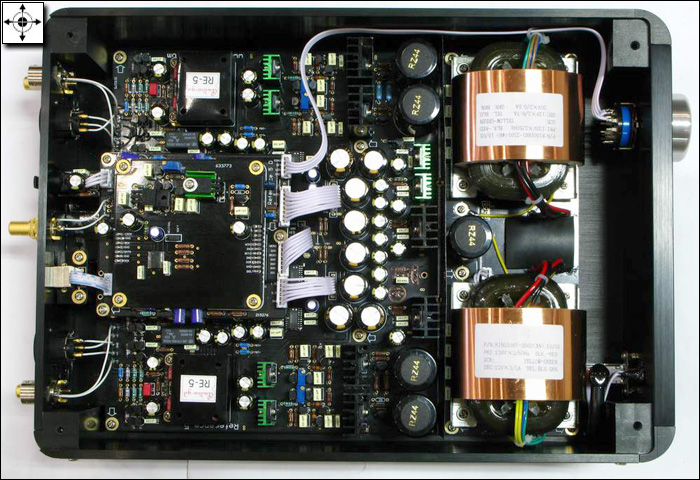This review page is supported in part by the sponsors whose ad banners are displayed below |
 |
 |
Description: The Audio-GD DAC won’t win beauty awards. Its design is massively old school and a study in sturdy brushed aluminum alloy with solid aluminum feet and elevated screw heads. The feet are conductive and the manufacturer advises against stacking the DAC on other gear. Apparently Audio-GD spent a minimum on those parts which wouldn’t impact the sonics significantly. The overall appearance nevertheless isn’t shabby and nicely avoids the ostentatious. The rounded corners are in fact the sole tribute to any flights of cosmetic fancy. Despite its basic nature, the input selector for coaxial, optical and USB feeds worked well.
|
 |
Once inside the aluminum casing, anyone should be impressed by the overall level of sophistication. The build quality is rather stunning at this price. Most parts are of the highest quality such as Dale resistors, Wima and Evox capacitors, Sanyo Os-Con Caps, WBT silver solders and a gold-plated IEC. The completely separated internal layout is particularly well done and each source of interference radiation (mostly R-core transformers and rectifiers) carefully shielded. There’s in excess of 25,000uf of audio-grade electrolytic capacitance customized to specification by UK supplier Nover and a total of nine stages to purify the power supply. To achieve silent operation, the control circuit is powered from a separate regulator. All transistors are Toshiba and Hitachi issue.
The DAC Reference 5 adopts the prior platform of the firm’s DAC-19 and is in fact its balanced version. He Qinghua is very clear on his website that this version represents value only in a fully balanced system. Otherwise get the DAC-19 and save bread. Taking into consideration further improvements in the Reference 5, this certainly demonstrates honesty.
|
|
|
The Ref 5 uses 4 x Burr-Brown PCM1704U-K multi-bit chips, i.e. two per channel for front-to-back differential signal processing. Qinghua and others consider the PCM1704UK one of the best-sounding chips, which boasts a 120dB S/N ratio. Unfortunately the PCM 1704 is out of production and represents the end of an era when sonic quality was first on the minds of the engineering labs. Today more versatile chips are cheaper to produce and offer added features on resolution and integration of built-in digital filters but tend to be Sigma/Delta types. These incorporate more technologies into one chip including two channels for stereo, volume control, upsampling and often even clock oscillators. Production costs are lower but sound quality no longer is the overriding concern. Regardless of how you view this, the PCM1704UK was quite famous and featured in several digital reference units by Theta and Wadia.
The Ref 5 DAC uses a proprietary digital filter simply called DSP-1 which is based on an Altera Cyclone processor said to be as fast as an Intel Pentium II with embedded memory, external memory interfaces and clock management circuitry. These Cyclone FPGAs are said to be an optimal solution for high-volume cost-sensitive applications and digital signal processing implementations. The DSP-1 Altera Cyclone is a two-channel digital interpolation filter and data processor for digital audio. It offers advanced features for high-performance DSP up to 250MHz. Data and master-clock processing are claimed to be jitter free. Theoretically at least the Reference 5 should deliver a precise analogue conversion of all digital inputs by achieving near perfectly reclocked streams. As their website claims, this improves the performance of transports from entry level to high-end.
|
 |
As the photos show, the power supply section is quite overbuilt. The larger supply contains 9 groups of parallel voltage regulator alone. Two copper-shielded R-Core power transformers feed the digital and analogue stages separately. Each and every stage of the circuit is heavily regulated. The Ref 5 operates in full class A without running too warm. It also includes Audio-GD’s so-called ACSS module based on a no-feedback discrete output stage. Each PCM1704U-K chip gets its own ACSS module whose technology is inspired by Krell’s current audio signal transmission or CAST mode. He Qinghua describes his 'proprietary' process as a compromise between global feedback and zero NFB. The digital signal is processed in the current rather than voltage domain to reduce transmission losses. Whatever output path chosen—XLR or RCA—the signal passes through these ACSS modules.
|
|
|
On its rear panel, the Reference 5 presents a choice of connections for a single source (or several sources connected in different modes). The three digital inputs are Toslink (an optical cable is included), coaxial on RCA and USB. All inputs accept up to 24-bit/96kHz data. 192kHz was impossible due to the PCM1704’s limitations. The USB input is based on the Tenor TE7022 48-pin IC known for its laid-back and not completely neutral sound. This chip includes a USB 2.0 compliant receiver. Its datasheet indicates that it handles data up to 96kHz at bit depths of 16 and 24 bits and that its integral volume control operates in the digital domain.
|
 |
There are three analogue outputs - one on RCA, one on XLR and one the ACSS/CAST implementation. To use the latter, one will necessarily own an Audio-GD preamp or Krell equivalent with CAST input. According to Krell the CAST wiring should expand usable audio signal bandwidth to well over 2MHz, ensuring that harmonic reflections are virtually immeasurable in the audible range. CAST also supports signal transmission over extended lengths of interconnect cables to allow for flexible placement of audio components without signal degradation.
|
 |
  |
 |